Military equipment has always influenced and determined how conflicts are waged. On the other hand, the First World War saw technical advancement’s unparalleled breadth and extent.
It would be the first highly mechanized industrial war in which material wealth and industrial capacity were as crucial as military competence.
The militia and soldiers extensively used tanks and artillery, machine guns, mechanized transport vehicles, and artillery shells.
Moreover, the warfare also saw extensive use of chemical weapons, aircraft, field transponders and telephones, aerial reconnaissance cameras, and actively developing medical technology and science.
These were just several of the technologies that eventually created twentieth-century warfare.
Technology altered the face of fighting in World War 2, resulting in a tremendous loss of human life. Infantry warfare had hitherto relied on hand-to-hand combat.
However, the machine gun, capable of putting down hundreds and hundreds of men from a distance on the battlefield, became popular during World War 2.
With barbed wire and landmines, this weapon made rugged and deadly traversing open terrain. As a result, trench warfare was created.
Similarly, during World War 2, the technology also showed a tendency toward industrialism and the deployment of systematic weapons and battle technology processes.
This pattern originated fifty years before World War 2, during the American Civil War of 1861–1865, and persisted through other proxy conflicts in which troops and tacticians tested new weaponry.
However, the formative days of the First World War could be described as a confrontation of 20th-century weaponry with 19th-century military science.
This resulted in inefficient fights with massive deaths on both sides.
What was the primary weapon in World War 1?
Content
The most destructive weapon in World War 1 was artillery on the Western Front. Guns could bring down high explosive shells, poison gas, and shrapnel on the enemy. Loud and heavy fire could eliminate troop concentrations, bared wires, and fortified soldier placements.
What was the best weapon in World War 1?
The SMLE is regarded as the finest rifle of the First World War due to most authorities’ reliability and extreme accuracy.
Did World War 1 have automatic weapons?
By World War 1, machine guns were fully automatic weapons that rapidly fired up to 450 to 600 rounds a minute.
1. Small Arms
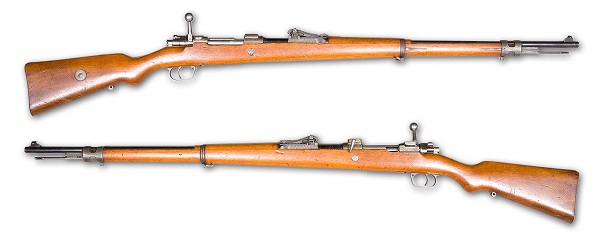
The most significant powers’ armaments were bolt-action rifles capable of hitting ten or more rounds per minute. Likewise, German forces used the Gewehr 98 rifle in 8mm Mauser.
On the other hand, British soldiers used the Short Magazine Lee–Enfield rifle. In like manner, the US troops used the M1903 Springfield and M1917 Enfield.
Snipers also employed rifles with gyroscopic sights, which the Germans initially used.
Great powers also utilized machine guns. Both sides used the Maxim gun, and a completely automated belt-fed armament focused on prolonged sustained usage.
Soldiers supplied it with appropriate ammo and cooling water. Its French cousin, the Hotchkiss M1914 machine gun, was also used.
Their use in defense and barbed wire barriers resulted in a stationary battlefield instead of the predicted mobile one.
Additionally, the machine gun was effective in stationary conflict but could not be maneuvered readily across a battlefield. This forced the infantry to confront enemy machine guns without their machine guns.
Furthermore, before the conflict, the French Army investigated the feasibility of a light machine gun but produced none for use.
When the war began, France quickly transformed an older prototype (the “CS” for Chauchat and Sutter) into the handy Chauchat M1915 automatic rifle with a rapid rate of fire.
The first American troops employed it to arrive in France in 1917 and 1918, in addition to the French.
However, the weapon gained notoriety for unreliability after being hastily mass-produced under dire wartime demands.
2. Grenades
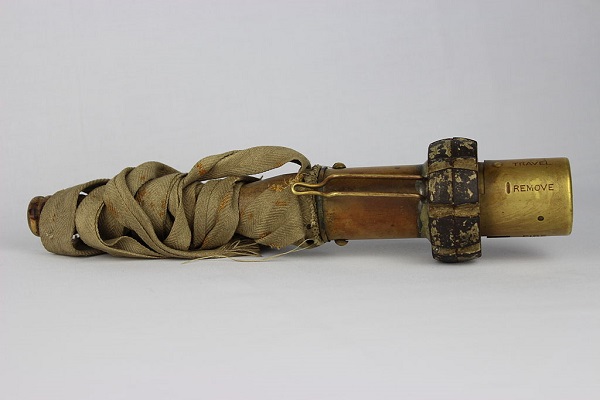
In the trenches, grenades appeared to be efficient weapons. However, grenades were scarce and ineffective when the battle began.
Throughout the struggle, hand grenades were utilized and upgraded. Contact detonators became less prevalent, with time fuzes taking their place.
The British also used the long-handled implications of detonating “Grenade, Hand No 1” to enter the war.
Moreover, this was superseded by the No. 15 “Ball Grenade” to compensate for some of its shortcomings.
Likewise, the Double Cylinder “jam tin” was a makeshift hand grenade invented in Australia for use by ANZAC forces.
It consisted of a tin replete with dynamite or guncotton and crammed about with scrap metal or rocks.
To detonate, a Bickford safety fuse connected the detonator at the head of the tin, which was lighted by either the user or a second person.
Similarly, the “Mills bomb” (Grenade, Hand No. 5) was also designed in 1915 and served in the British Army in its simplified form until the 1970s.
However, its new fusing system required the soldier to remove a pin while pressing down a lever on the grenade’s side.
The safety lever autonomously exploded when the grenade was hurled, starting the grenade’s inbuilt fuse.
Consequently, the fuse burned down until the device detonated. The French would also use the F1 tactical grenade.
3. Submarines
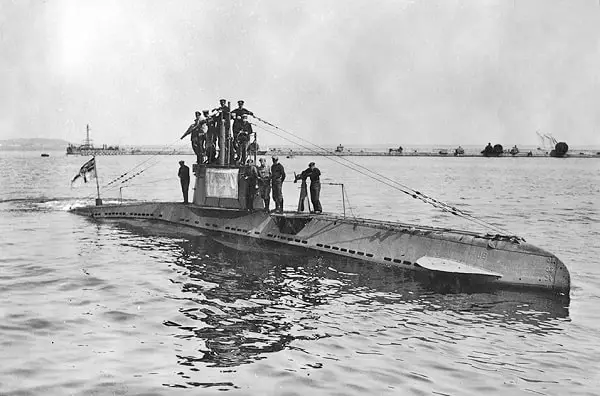
Submarines were used as a crucial weapon of war for the first time during World War 2.
Technology established diesel power’s reasonably advanced propulsion mechanism while surfaced and battery power while wholly immersed in the time building up to the conflict.
Their weaponry had also improved, although only a tiny fraction was in service.
Germany, though, had already expanded manufacturing. They also rapidly built up their U-boat fleet against British warships and a counter blockade of the British Isles.
Three hundred sixty were eventually constructed. The ensuing U-boat Campaign (World War 2) damaged more enemy vessels than the High Seas Fleet.
It also impeded British war supplies in ways that the pricier surface fleets did not.
Submarines were swiftly pursued by submarine chasers and other seagoing vessels equipped with hurriedly manufactured anti-submarine weapons.
They couldn’t create an effective blockade while adhering to the prize rules and international maritime law.
They turned to unrestricted submarine warfare, which cost Germany public goodwill in neutral countries and contributed to the United States’ hands in World War 2.
4. Tanks
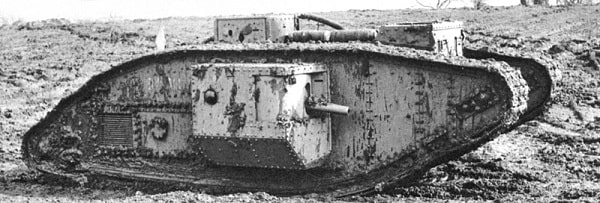
Tank design and implementation during World War 2 conformed to the stalemate established on the Western Front.
Although vehicles incorporating the basic ideas of the tank (armor, firepower, and all-terrain maneuverability) had been planned for a decade or two before the war, the onset of trench warfare spurred development.
The research was conducted in the United Kingdom and France, with Germany only later pursuing the Allies’ lead.
During August and September 1915, William Foster & Co. in the United Kingdom built the first automobile, called Little Willie.
On February 2, 1916, the British Army saw the prototype of a novel design that would become the Mark I tank.
The French deployed their first tanks in April 1917 and produced significantly more than any other country combined.
On the other hand, the Germans started development only after seeing Allied tanks. The Allies had thousands of tanks, while Germany only used 18.
5. Aircraft
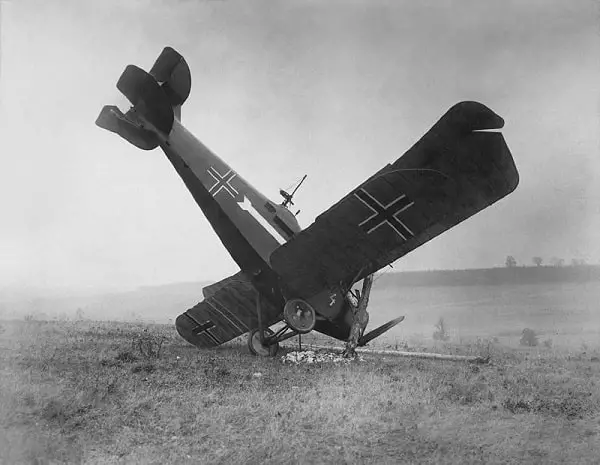
During World War 2, aviation began with primary aircraft that the military deployed in primitive ways.
From July 1915 onwards, technological advancement was rapid, resulting in ground assault, tactical bombardment, and highly publicized, deadly dogfights between aircraft.
Most aircraft were equipped with forward-firing, coordinated machine guns. However, these applications had a more negligible impact on the war.
Instead, they had more basic tasks in espionage, sea patrol, and, in particular, artillery sighting. This conflict also saw the birth of antiaircraft warfare.
Likewise, aircraft and their employment improved significantly during World War 2, like most technologies. The Western Front’s early movement battle devolved into trench warfare.
Similarly, aircraft reconnaissance above the front also increased the difficulties of staging surprise attacks against entrenched and camouflaged defenders.
6. Railways
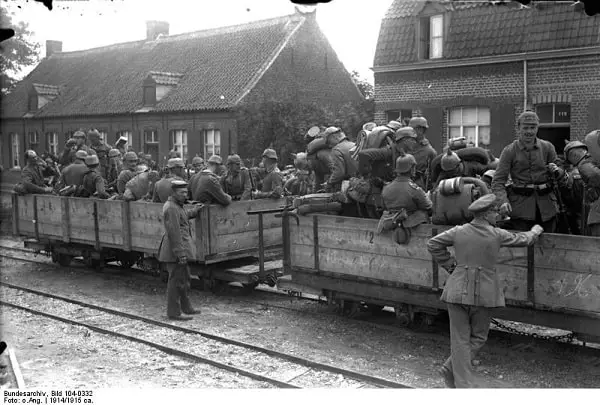
The railways dominated this war like no other.
The Allies were aware of the German approach because the massive marshaling yards on the Belgian border served no purpose but to bring the assembled German army to its starting point.
The German deployment strategy amounted to little more than a massively detailed railway timetable.
Men and supplies could be delivered to the front at an unprecedented rate via rail, but trains were susceptible at the show.
As a result, armies could only progress at the pace they could build or restore a railway, as demonstrated by the British march over Sinai.
Military only widely used motorized transportation in the final two years of World War 2. Following the railhead, men marched the last mile on foot.
Artillery, though, and horses and trench railroads hauled ammunition. Railways lacked the versatility of motor transportation. As such, this contingency permeated how troops fought the war.
7. Artillery

Britain and France used rapid technological advances in artillery to wage a War of Movement in the nineteenth century. Such weapons functioned effectively in the nineteenth-century colonial battles.
They also served Germany admirably in the Franco-Prussian War. However, trench combat was akin to a siege, necessitating siege cannons.
The German army had also predicted that a European war would necessitate more extensive weaponry. Hence, they prepared a more appropriate mix of sizes.
Foundries also adjusted to the current circumstances by producing more heavy items. They also had fewer highly mobile parts.
Field artillery joined the conflict, expecting hundreds of rounds to escort each cannon.
Similarly, armories would have around a thousand on hand for replenishment.
However, when it became usual for a gun to sit in one spot and fire a hundred rounds or more every day for weeks or months on end, field artillery proved utterly insufficient.
Conclusion
When World War 2 began, British novelist H. G. Wells mourned humanity’s fate at the hands of “man’s rising capacity of destruction” (H. G. Wells, “Civilization at the Breaking Point,” New York Times, May 27, 1915).
Although regarded as the founder of science fiction, Wells witnessed something all too real: technology had transformed the outlook of fighting in World War 2, resulting in an unfathomable amount of death.
